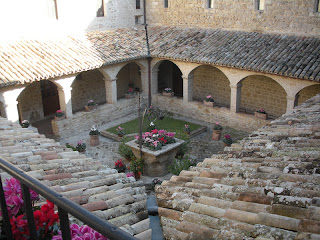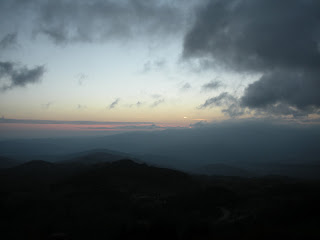A good part of saturday was spent outside the wall. The day began before dawn when a group of us made our way to St. Peter's Basilica for Mass on the Feast of St. Leo the Great. Leo basically started the papacy in terms of power, scope and authority. He was Pope at the time when there was no emperor in Rome. The Emperor's moved to Turkey with their troops to the "New Rome", Constantinople. The only person in any leadership role was the Bishop of Rome and people asked Leo what to do. He organized the city, wrote kings for help in defending the City and in the most famous episode of his papacy rode out of the City to personally face the most terrifying and dreaded figure of his age, Attila the Hun. We don't know how or what Leo said to convince Attila to turn around and go home but whatever he did it worked and the people, along with the City, were spared the from Huns terrible destructive forces. Of course, Leo did so much more but you can read about that in the history books!
At St. Peter's we had a bit of difficulty getting in through the normal gate we use but a very nice American Priest with a special sort of passport for saying Mass in St. Peter's came to our rescue, like Leo. He waived his passport a the Police saying only, "Their with me" and like magic we were permitted to pass. We had already cleared the Swiss Guard check point and the young guard warned us the crabby policeman at the top would only be sending us back to him. He was right but by God's providence that nice American came by and spared us! Then inside it was not easy to find an Altar since this is a popular feast here in Rome (for good reason since Leo spared the City). We eventually were given access to the Confessio where we had Mass at the Chapel of Our Lady of Guadalupe, Patroness of the America's!!! Talk about Divine Providence! It is a chapel very close to St. Peter's bones.
After that I made the long trek outside the City to a very ancient Church of St. Agnes and then to St. Costanza. St. Agnes was an early Christian Martyr. She is beloved here in Rome. She was 12 years old when she refused to sacrifice to the Roman God's and refused to be violated as she took a vow of perpetual virginity. The story says she was stripped naked in the what is now the Piazza Navona but her hair grew and covered her modesty. She was then dragged to a brothel but when the first man tried to rape her he was struck down, she forgave him and he was restored to health and converted to Christianity. She was then taken back to the Piazza Navona to be burned alive for the entertainment of the crowds but the flames parted around her as she prayed. Finally she was stabbed in the neck and died. She was buried in her families plot well outside the city. One interesting point is that her servant was a woman named Emerentiana, a Catechumen. She faithfully visited the grave, was herself a virgin and was martyred on while visiting the grave. They are buried together. The interesting point is this, she was not yet a Christian. The people of Rome were astonished and edified by her witness and considered her a saint. They asked the Bishop of Rome if this were acceptable and his reply was that she died as a Christian because though she had not been baptized by water she was baptized by blood. Thus as many Catholic's know there is baptism by water, by desire and by blood. The blood part came as a result of Emerentiana's martyrdom.
I did some geocashes and then to a dinner at Casa Santa Maria and a concert at the Church of the 12 Apostles. This week is a series on Sacred Music here in Rome. I leave for Assisi Sunday morning.
 |
| Mass in the Confessio at O.L. Guadalupe Altar |
Oh, I forgot to mention we went out for breakfast afterwards. Some of us had the very traditional Roman breakfast of Cappuccino and Corinetti while others craved an "American" breakfast of eggs, bacon and toast. I only ate one of these Corinetti, these are chocolate filled with nutella, heavenly!!! Notice how artistic the Italians are, this cappuccino has a little leaf in the cream. I have had leaves, hearts, funny faces, all manner of creative things made in my cappuccino cream!
 |
| Delicious |
We all laughed at this photo I took. This is Fr. Paul Josten of the Dakota's. He said, "I don't know what is the matter with me, I am happier to see this breakfast than the Sistine Chapel, what does that say about me??" We all laughed hysterically. These boys are ready to come home. As it turns out the "American Breakfast" is the Italian version. The eggs served as a baked omelette and the bacon were two slabs of ham. It was served with raw tomato and black olives. But those who ordered it were happy to eat it.
 |
| Happiness is bacon and eggs! |
Here are two pictures of the tomb of St. Agnes and St. Emerentiana. I had to take it in two parts. The whole thing is covered in little dragons and eagles, the Coat of Arms of Pope Paul V Bourghese. Some thought the Pope was showing off but this was buried under the Altar until excavations in the 20th Century allowed it to be viewed and touched. Paul V was indeed quite vain but in this case he never intended for this to be seen, it was a personal gift of personal devotion when he had the remains transferred to this bronze coffin.
This is picture of St. Constanza Church. She was the daughter of Constantine the Great. It was originally a Mausoleum and many members of the Imperial Family were buried here. It was built next to St. Agnes because Constanza had a deep devotion to Agnes. You can see a plaster copy of the tomb in the background, I showed you the original which is porphry and is in the Vatican Museums with her grandmother's tomb, St. Helena. It is a round Church.
 |
| St. Constanza Church |
To get to St. Anges and St. Constanza you have to cross through the beautiful Porta Pia. This side of the city gate is the view from inside the City, it was designed and executed by Michelangelo. When the Italians stormed Rome to take it from the Papacy and make it the Capitol of the Unified Italy they bombarded this gate heavily. The other side suffered significant damage from the shelling that lasted several days and was almost completely destroyed. Today the outside has been restored but the this side was not damaged.
 |
| Porta Pia |
Here is a blurry view of the Church of the 12 Apostles where the concert was last night. It has great crystal chandeliers. This is the Church where SS. Philip and James are buried.
 |
| Church of the 12 Apostles. |





















































